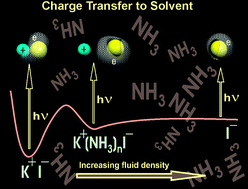Development of the charge-transfer-to-solvent process with increasing solvent fluid density: the effect of ion pairing
Abstract
The study of the UV spectroscopic behaviour of alkali metal iodides dissolved in supercritical

* Corresponding authors
a INQUIMAE-DQIAQF, Facultad de Cs. Exactas y Naturales, Universidad de Buenos Aires, Ciudad Universitaria, Pabellón II, Buenos Aires, Argentina
b
Unidad de Actividad Química, Comisión Nacional de Energía Atómica, Av. Libertador 8250, Buenos Aires, Argentina
E-mail:
rfprini@cnea.gov.ar
The study of the UV spectroscopic behaviour of alkali metal iodides dissolved in supercritical

 Please wait while we load your content...
Something went wrong. Try again?
Please wait while we load your content...
Something went wrong. Try again?
G. Sciaini, E. Marceca and R. Fernández-Prini, Phys. Chem. Chem. Phys., 2006, 8, 4839 DOI: 10.1039/B608600B
To request permission to reproduce material from this article, please go to the Copyright Clearance Center request page.
If you are an author contributing to an RSC publication, you do not need to request permission provided correct acknowledgement is given.
If you are the author of this article, you do not need to request permission to reproduce figures and diagrams provided correct acknowledgement is given. If you want to reproduce the whole article in a third-party publication (excluding your thesis/dissertation for which permission is not required) please go to the Copyright Clearance Center request page.
Read more about how to correctly acknowledge RSC content.
 Fetching data from CrossRef.
Fetching data from CrossRef.
This may take some time to load.
Loading related content
